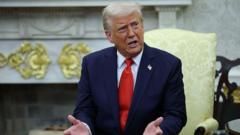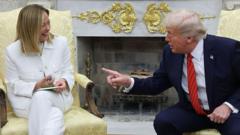Former President Donald Trump is sharpening his focus on trade with China, marking a significant shift in his approach to international trade relations. The current landscape, characterized by a universal 10% tariff on goods from various countries and a staggering 125% tariff specifically on Chinese imports, highlights his long-standing antagonism towards Beijing. This latest move follows China's retaliatory 84% tariff on US products, which Trump labels as a display of disrespect.
**Trump's Renewed Trade War: An Examination of US-China Relations**

**Trump's Renewed Trade War: An Examination of US-China Relations**
In light of rising tariffs, this article analyzes Trump's trade strategy against China and its potential implications on global trade dynamics.
At the core of Trump's strategy lies unfinished business from his presidency. He asserts that this new escalation represents a corrective measure to what he perceives as the previous administration's failure to address China’s growing economic dominance. Historically, increased trade with China was viewed positively, bolstering global growth and opening markets for Western goods. However, a different narrative has emerged, with Trump branding China as a primary culprit in the decline of American manufacturing jobs and the erosion of economic stability.
The tensions surrounding trade have persisted, with President Joe Biden maintaining many of Trump’s tariffs, even as China’s economic strength continues to expand. The nation now holds a significant portion of global manufacturing, including 60% of electric cars and a majority share of the batteries powering them, illustrating the challenge the US faces in altering the existing economic paradigm.
The future of US-China trade negotiations hinges on several pressing questions: Will China accept talks with America, and if so, will it concede to the extensive reforms the US demands? These uncertainties place both nations in an unprecedented situation, making predictions difficult. China's strategy is tightly interwoven with its national identity and the principle of economic supremacy, suggesting a reluctance to compromise on their protective measures.
Moreover, there is an essential question for the US to confront: Does America still endorse the principles of free trade? Trump's view of tariffs as beneficial for domestic growth and investment calls into question whether the US truly seeks a cooperative economic relationship or aims to dominate in a zero-sum competition against China.
If both countries escalate their protectionist policies without reaching a consensus, such a shift could signify a definitive break from established trade norms, leading to a precarious future for global economic relations. The implications of this rivalry may extend beyond bilateral trade, influencing markets and economies worldwide.
As the world watches, the outcome of these developments will shape the future of US-China relations and the broader economic landscape for years to come.
The tensions surrounding trade have persisted, with President Joe Biden maintaining many of Trump’s tariffs, even as China’s economic strength continues to expand. The nation now holds a significant portion of global manufacturing, including 60% of electric cars and a majority share of the batteries powering them, illustrating the challenge the US faces in altering the existing economic paradigm.
The future of US-China trade negotiations hinges on several pressing questions: Will China accept talks with America, and if so, will it concede to the extensive reforms the US demands? These uncertainties place both nations in an unprecedented situation, making predictions difficult. China's strategy is tightly interwoven with its national identity and the principle of economic supremacy, suggesting a reluctance to compromise on their protective measures.
Moreover, there is an essential question for the US to confront: Does America still endorse the principles of free trade? Trump's view of tariffs as beneficial for domestic growth and investment calls into question whether the US truly seeks a cooperative economic relationship or aims to dominate in a zero-sum competition against China.
If both countries escalate their protectionist policies without reaching a consensus, such a shift could signify a definitive break from established trade norms, leading to a precarious future for global economic relations. The implications of this rivalry may extend beyond bilateral trade, influencing markets and economies worldwide.
As the world watches, the outcome of these developments will shape the future of US-China relations and the broader economic landscape for years to come.





















